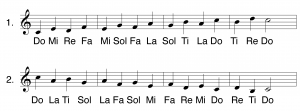Sing a Little
The guitar is not a very ear intensive instrument. We tune up, then we go. It’s not like winds or voices or other strings: we don’t have to constantly be on guard and adjust our tuning on the fly (theoretically). It’s Important that we work to develop our ear, and singing is one of the best ways to do that. Here’s three things to do to start your singing journey.
1. Learn a Solmization System
Hearing music is about hearing hierarchy. Some notes are more important that others. As Reginald Smith Brindle said, “Melody is like speech. It has to have many unimportant words to build up the significance of those that really matter.”
I learned traditional solfege with movable do. I suggest this to those of you wanting to start your singing journey. It’s fairly easy to get a handle on. In reality the syllables don’t matter, and there are other solmization systems out there. What matters is that each note (including chromatic notes) gets it’s own unique syllable that has to do with it’s relation to the key. The leading tone (scale degree 7) is always Ti; tonic is always do, etc. This helps reinforce the hierarchy of pitches and the way tendency tones (including those that imply modulation/tonicization) operate in a key.
Get started by learning to sing a major scale, Do Re Mi Fa Sol La Ti Do, both up and down.
2. Sing Tonicization Patterns and Other Exercises
A tonicization pattern is just a quick series of notes that, when sung, helps fix a key in your head. You actually don’t need any instrument to practice singing. Just run a quick tonicization pattern and start singing. Here are patterns for Major and Minor. Note: this is La based minor.


Notice that each of those covers all the notes in a key (here in C major and Minor) and outlines the harmonic progression I IV I V I, that’s what makes these so useful.
Next up are some exercises. Here are a few dealing with thirds.
3. Memorize Some Melodies
Take a few melodies you’re already familiar with. Memorize them using solfege. I have to do this for a class right now, so I chose Greensleeves, The Harmonious Blacksmith, and some Christmas tunes.
This gives you a musical vocabulary on which to fall back. Learning a complete melody is also one of the best ways to practice various intervals, and it’s more interesting than trying to just sing intervals all the time.
After you’ve got a few melodies memorized practice writing them while you sing. Do this in various keys. Why? It’s practice associating the written way musicians communicate (notation) and the aural. In short, it’s practice translating what you hear into what’s on paper. Writing it in various keys just helps reinforce how your solmization system fits into any key (movable do, again). This is also good practice for melodic dictation later on.
Wrap Up
This is the method outlined by my Pedagogy of Theory teacher. Of course, if you can’t do this stuff you can’t teach it, so the class has to pretty much be doing this curriculum. I can tell you that just practicing singing a little bit each day has done wonders for my ear. Try this stuff out for a few months and see what happens.


Jeffrey Bianchi
One of the best things someone can do to really help solidify a piece and make it “sing” is to be able to sing the melodies, bass lines, etc. from memory via solfege. It is a lot of work, but once you see the results you never go back.
Nikolay G
Hey Chris!
Great post about the benefits of singing and solfege, I have one question though. What’s happening in that second example (Minor Tonicization Pattern)? Is it just a typo or am I seeing things? The names of the notes seem to be all over the place.
Nikolay G
Lol never mind, I just looked it up on Wikipedia. Never knew about the “movable do” thing, is that how they teach it here in the US?
Christopher Davis
Yep, they do movable do here. So the solfege syllables are dependent on key.
Dominic
Sound advice (and with a beginner you can get them to harmonise their singing with simple “one finger” C and G7 chords).
I’ve not seen Reginald Smith Brindle quoted for a long time! Last time I came across him was a book he wrote about serial composition.
Christopher Davis
Dominic, I really like his book about Serial Composition. Reading it was the first time I thought about the relative stability/instability of intervals and how that, and other compositional devices other than harmony, can help support a build up of tension in release in a piece. Very interesting stuff.
I think that quote was taking from his composition book.